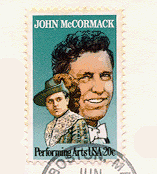
 John McCormack(1884 -- 1945) --:
This stamp marks the second joint issue between the Irish Post Office and the Postal
Services of the United States of America. The stamps were jointly issued on 6th. June,
1984 to commemorate the Centenary of the birth of John McCormack. The joint issue featured
the same design on both stamps here and in the United States, as with the previous issue
of James Hoban stamp in 1981.The Irish stamp was issued as a single 22p stamp and a single
20c stamp in America.
John McCormack(1884 -- 1945) --:
This stamp marks the second joint issue between the Irish Post Office and the Postal
Services of the United States of America. The stamps were jointly issued on 6th. June,
1984 to commemorate the Centenary of the birth of John McCormack. The joint issue featured
the same design on both stamps here and in the United States, as with the previous issue
of James Hoban stamp in 1981.The Irish stamp was issued as a single 22p stamp and a single
20c stamp in America.John McCormack was one of the greatest tenors of this century.He
was born in Athlone, County Westmeath, Ireland on June 14th., 1884,one of five children to
survive out of a family of eleven born to a mill worker and his wife.Leaving school at the
age of eighteen in 1902 , he joined the Palestrina Choir of the Pro-Cathedral in
Dublin. The following year he won the gold medal in the tenor section of the National
Music Festival or Feis Ceoil.
A brief appearance at the St.Louis World Fair in 1904 was followed by his recording debut
in London, after which he moved to Milan,in Italy to be trained by Maestro
Sabbatini. He only received one year of formal training throughout his whole career as a
singer.He made his operatic debut at the Teatro Chiabrero in Savona on 13th. January,
1905, in the title role of Mascagni's L'Amico Fritz. He returned to London in
1907 and in October of that year made his debut in the Royal Opera,Covent Garden in Cavalleria
Rusticana. at the age of twenty three he was the youngest tenor to sing a major role
in that theatre. He remained at Covent Garden for eight successive seasons until the first
World War closed the house. The Times of London in 1913, said of his voice that :
"The combimned strength and beauty of its quality now places him in the front ranks
of tenors". Praise indeed.
In 1909 he crossed the Atlantic again to make his debut at the Manhatten Opera House. In 1910 he appeared in the Metropolitian Opera House(The Met) with Nellie Melba. In 1911 he toured Australia as Melba's leading tenor.
It is on the concert stage rather than the operatic stage that McCormack really shone.On the platform he demonstrated a gift of commmunication that was supereb to watch and listen to.He became the first real music "Superstar" and travelled extensively throughout the United States , filling concert venues to capacity. whereever he sang.Standing room only became the norm as people flocked to hear and see this great Irish tenor, "he has become a National Institution" declared the Pictorial Review in 1916.In June 1919 the tenor became an American citizen.
Im 1928 he was raised to the Papal Peerage, the honour he most cherished amomng the
many he received. and it was as a Papal Count that he sang "Panis Angelicus" at
the High Mass which concluded the Eucharistic Congress held in Dublin in 1932.He retired
from the concert stage in 1938, but made a tour on behalf of the Red Cross during the
Second World War and he continued to make recordings until 1942. He died at his residence
"Glena" in Bootersown, County Dublin on September 16th,1945, aged sixty one, and
is buried in Dean's Grange Cemetry, Dublin.